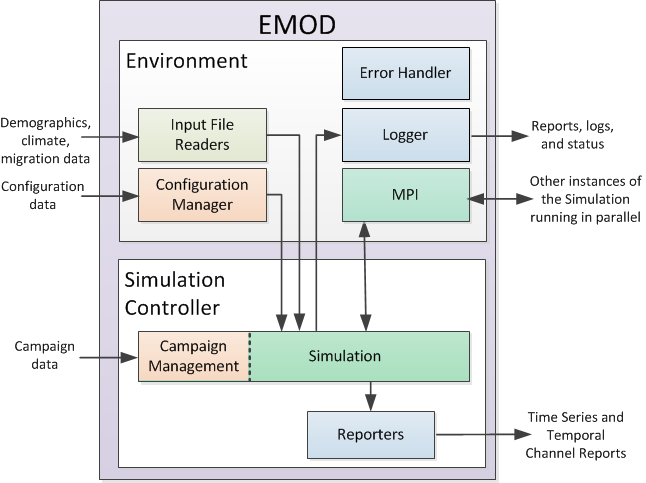Environment subsystem¶
The environment subsystem provides access to global resources and most of the external input and output interfaces. Output reports are the only output not handled through the environment subsystem. It consists of a a singleton utility class, Environment. The environment subsystem consists of five logical components.
The following figure shows a high-level view of the system components of EMOD and how they are related to each other.

EMOD system components¶
Input file readers¶
Provide small utility functions for reading in the input data, configuration, and campaign files. The actual parsing of the configuration and campaign files is done by the configuration manager component. The parsing of the input files is done by the model classes that consume that data, which are part of the simulation controller subsystem.
Configuration manager¶
Parses the configuration files, stores the parsed values for system-global configuration values, and provides a central container resource for the configuration as JSON to those classes that need to parse out the remaining configuration values locally for themselves. It retains the contents of the configuration file and the directories provided on the command line.
Error handler¶
Provides an application-level exception library and a centralized mechanism for handling all errors that occur during program execution. These errors are ultimately reported through the logging component.
Logger¶
Writes the output logs and errors. Output reports, such as time-series channel data reports, spatial channel data reports, progress and status summary, and custom reports, are handled by the simulation controller. For information and setting the logging level, see Set log levels.
Message Passing Interface (MPI)¶
EMOD is designed to support large-scale multi-node simulations by running multiple instances of EMOD in parallel across multiple compute nodes on a cluster. During initialization, geographical nodes are assigned to compute nodes. Individuals who migrate between geographical nodes that are not on the same compute node are migrated via a process of serialization, network I/O, and deserialization. The network communication is handled through a mixture of direct calls to the MPI library and use of Boost’s MPI facilities. This component provides the system-wide single interface to MPI, caching the number of tasks and rank of current process from the MPI environment.